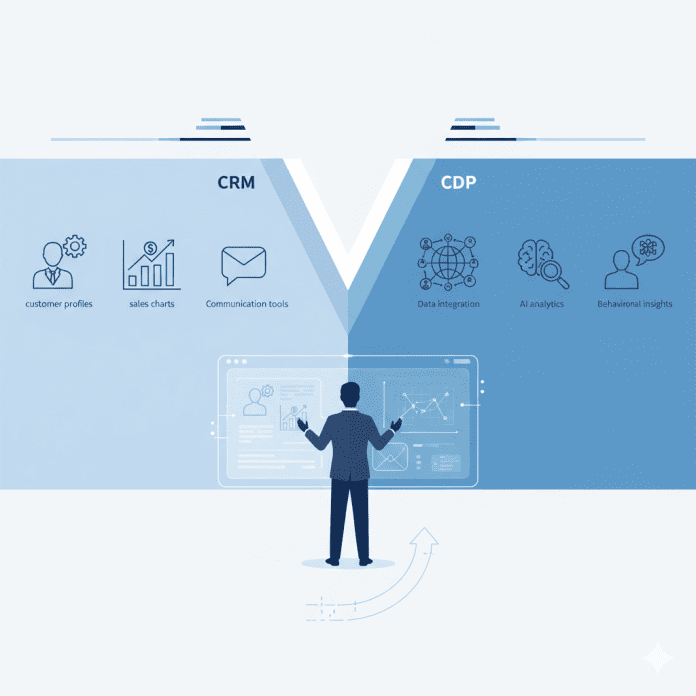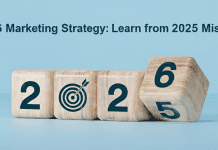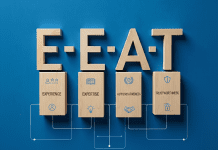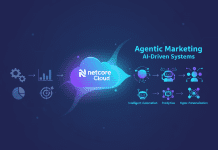B2B marketing in 2025 is more data-driven than ever before. With customer journeys expanding across multiple touchpoints, email, chat, social, events, and third-party intent platforms, marketers face one clear challenge: integrating and using data effectively to drive revenue. Two tools dominate this ecosystem, the Customer Relationship Management (CRM) platform and the Customer Data Platform (CDP).
While both manage customer information, they serve very different purposes. CRMs track individual relationships and pipeline progress, whereas CDPs unify scattered data from multiple channels to build a single, actionable customer profile. Yet, many businesses still confuse the two or invest heavily in one without realizing what’s missing.
According to a 2025 Gartner report, over 68% of B2B enterprises admit their data remains fragmented across marketing and sales tools, directly impacting lead quality and conversion. The growing push toward hyper-personalized engagement and AI-powered automation has made it critical to know where each tool fits in the stack. This article unpacks CDP vs CRM, what they are, how they differ, and which one deserves priority for B2B marketers aiming to scale efficiently in 2025 and beyond.
Understanding CRM in Modern B2B Marketing
A Customer Relationship Management (CRM) system is the backbone of most sales-driven organizations. It records every interaction with prospects and customers, emails, calls, demos, follow-ups, creating a historical log that supports lead nurturing and sales forecasting.
Modern CRMs like HubSpot, Salesforce, Zoho, and Microsoft Dynamics 365 have evolved far beyond basic contact management. They now include AI-driven lead scoring, predictive analytics, and workflow automation, enabling teams to prioritize high-value leads and reduce response time.
In B2B marketing, CRM systems are central to pipeline management. They allow visibility into where each opportunity stands, which campaigns generated it, and what revenue it’s likely to produce. The tool also ensures collaboration between marketing, sales, and customer success teams, aligning everyone on the same set of performance metrics.
However, CRMs mainly rely on known data, the leads and customers already in the system. They’re excellent for managing existing relationships but fall short in handling anonymous engagement data from multiple sources like website visits, social engagement, or third-party content platforms. That’s where CDPs step in.
Understanding CDP and Its Growing Role
A Customer Data Platform (CDP) is designed to solve one of modern marketing’s biggest problems, data fragmentation. It aggregates data from every touchpoint, websites, CRM, ad platforms, marketing automation tools, and even offline systems, to create a unified customer profile.
In simple terms, a CDP gives marketers the complete story of every user, from first interaction to purchase, in one place.
CDPs like Segment, Tealium, and Adobe Experience Platform automatically clean, deduplicate, and standardize incoming data, making it actionable across all marketing channels. For example, if a potential buyer downloads a whitepaper, attends a webinar, and later clicks an email campaign, the CDP stitches these actions together to identify that person’s intent and stage in the funnel.
In 2025, the rise of AI-powered CDPs is transforming how B2B brands use data. They can now generate predictive insights such as churn risk, buying propensity, and content preference, allowing marketers to deliver relevant campaigns in real time. The outcome is greater personalization, better lead quality, and more efficient marketing spend.
CDP vs CRM: The Core Difference
The fundamental difference between a CDP and CRM lies in their purpose and data scope.
- A CRM manages relationships and tracks direct interactions between your business and customers.
- A CDP consolidates and organizes customer data from all digital and offline sources to deliver a complete, actionable customer view.
While CRM data is often manually entered by sales or marketing teams, CDP data is automatically collected from multiple systems and behavioral inputs. The CRM’s strength lies in relationship management, while the CDP’s power is in data unification and insight generation.
From a funnel perspective, CRMs work best in the middle and bottom stages, managing known prospects, deals, and post-sales interactions. CDPs dominate the top and middle stages, identifying intent, scoring engagement, and delivering personalized content before a lead ever reaches the CRM.
Integration Challenges Between CDP and CRM
Although both platforms complement each other, integrating them is not always straightforward. The first challenge is data synchronization. Since CRMs store structured data (contacts, deals, activities) and CDPs manage behavioral data (clicks, engagement, browsing), aligning schemas can be complex.
The second barrier is data privacy compliance. With global regulations such as GDPR, CCPA, and India’s DPDP Act, marketers must ensure that personally identifiable information (PII) is securely transferred and consent-based.
A third challenge is operational alignment. Many organizations deploy both tools but fail to define ownership. Marketing often manages the CDP, while sales controls the CRM, leading to disconnected workflows and reporting. The solution lies in setting up a shared data governance framework, where both systems feed into a single marketing-sales intelligence layer.
When to Prioritize One Over the Other
Deciding between a CDP and CRM depends on business maturity, marketing complexity, and customer journey sophistication.
When CRM is enough:
Startups or smaller B2B firms focused on relationship-driven growth benefit from CRMs. If the sales process involves direct outreach, limited data sources, and smaller account volumes, a CRM handles it effectively. It tracks deals, communications, and follow-ups without the overhead of advanced data orchestration.
When CDP becomes essential:
For mid-to-large enterprises running multi-channel campaigns, using multiple ad networks, and handling vast prospect data, a CDP becomes indispensable. It eliminates data silos, ensures message consistency across channels, and provides real-time insights. In industries like SaaS, e-commerce, and manufacturing, CDPs enhance targeting precision and reduce wasted ad spend.
Ultimately, B2B brands that rely on account-based marketing (ABM) or intent-based segmentation cannot achieve full efficiency without a CDP layer feeding accurate, unified data to their CRM.
The Business Case: ROI and Efficiency
Investing in the right data system impacts not only marketing operations but also the company’s bottom line.
Research from Forrester (2025) shows that companies using both CDP and CRM systems together see a 35% improvement in lead-to-customer conversion rates and a 27% faster sales cycle compared to those using CRM alone.
CRMs improve sales efficiency, reducing manual tracking and enhancing pipeline accuracy. CDPs improve marketing ROI, reducing cost per acquisition by ensuring campaigns reach the right audience at the right time.
Together, they create a closed loop between insight and action, marketers generate qualified leads through the CDP, and sales teams convert them using CRM-based engagement workflows.
How CDP and CRM Work Together
Rather than viewing CDP and CRM as competitors, forward-thinking B2B marketers see them as complementary.
The CDP acts as the data foundation, collecting and preparing customer information for analysis and segmentation. The CRM then acts as the activation engine, using that enriched data to drive personalized communication and manage relationships.
For example, when a CDP detects that a potential client has engaged with pricing pages and product comparisons, it sends this insight to the CRM. Sales can then prioritize outreach with a tailored pitch, increasing close rates.
This integration also enhances marketing attribution, as both systems share unified identifiers, helping decision-makers understand which campaigns or channels truly drive revenue.
In 2025, the most successful organizations are not choosing between CDP and CRM, they’re building a synchronized martech stack that merges both for 360-degree visibility and performance.
Future Trends in 2025 and Beyond
As AI continues to reshape the marketing technology landscape, the lines between CDP and CRM will blur further.
Future CRM systems will integrate deeper AI layers for predictive sales forecasting, while CDPs will incorporate real-time orchestration engines capable of dynamic audience segmentation.
Another emerging trend is data composability, where both systems connect through APIs to create flexible, scalable data pipelines rather than rigid integrations. This allows marketers to experiment faster, test personalization models, and deliver consistent omnichannel experiences.
Moreover, privacy-first architecture will become standard. Platforms that can manage consent dynamically, ensuring compliance while preserving personalization, will dominate the next wave of B2B martech evolution.
By 2026, Gartner predicts that 80% of B2B enterprises will operate on unified CDP-CRM frameworks, reducing data duplication and boosting customer lifetime value (CLV) by up to 40%.
Conclusion
In the CDP vs CRM debate, there is no one-size-fits-all answer. CRMs remain the cornerstone of sales engagement and relationship management, while CDPs are essential for mastering audience understanding and personalization.
For B2B marketers in 2025, the smartest move isn’t choosing one over the other but ensuring they work in harmony.
When combined, these systems create a connected ecosystem, one where marketing generates high-intent leads through data-driven precision, and sales convert them through contextual, timely communication. That’s the future of B2B growth, insight-led, automated, and customer-centric.
At MartechEdge, we help B2B organizations stay ahead of the curve by decoding martech innovations, exploring emerging technologies, and providing actionable insights that drive qualified leads into your funnel.
I hope you find the above content helpful. For more such informative content, please visit Martecedge.
FAQs:
1. What’s the key difference between a CDP and a CRM in B2B marketing?
A CRM (Customer Relationship Management) system is primarily designed to manage interactions with existing and potential customers, focusing on sales, pipelines, and customer communication. In contrast, a CDP (Customer Data Platform) collects and unifies customer data from multiple touchpoints, such as web behavior, campaigns, and third-party platforms, providing a single, actionable customer view for marketing and analytics.
2. Can a company use both a CDP and CRM together?
Yes, and in fact, they should. A CRM manages customer relationships and sales processes, while a CDP enhances it by providing enriched, real-time data insights. Integration between the two ensures marketing and sales teams operate on consistent, data-backed intelligence across channels.
3. Which is more cost-effective for startups and small B2B businesses, CDP or CRM?
For smaller organizations, starting with a CRM is more practical and cost-efficient. As the company scales and data sources multiply, investing in a CDP becomes crucial to automate segmentation, improve targeting, and personalize marketing campaigns effectively.
4. How does AI enhance the value of CDPs and CRMs in 2025?
AI is transforming both platforms. In CRMs, AI optimizes lead scoring, automates follow-ups, and predicts deal closures. In CDPs, AI enhances data unification, intent prediction, and audience segmentation, allowing B2B marketers to target leads with higher precision.
5. What should B2B marketers prioritize in 2025, CDP or CRM?
The choice depends on business maturity. If your focus is on managing relationships and tracking sales, prioritize a CRM. But if your goal is to leverage cross-channel data for predictive marketing and personalization, invest in a CDP, or better, integrate both for a full-funnel approach.










